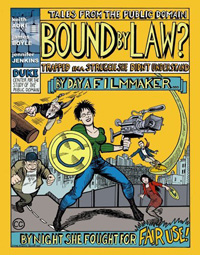 Keith Aoki, James Boyle and Jennifer Jenkins have produced a comic book entitled, “Bound By Law? Trapped in a Sturggle She Didn’t Understand” which portrays a fictional documentary filmmaker who learns about intellectual property, copyright and more importantly her rights to use material under fair use. We picked up a copy during the recent conference on “Cultural Environmentalism at 10” at Stanford. This work was funded by the Rockefeller Foundation, the same people who funded “Will Fair Use Survive?” from the Free Expression Policy Project of the Brennan Center at the NYU Law School, which was discussed here upon its release. The comic book also relies on the analysis that Larry Lessig covered in “Free Culture.” However, these two works go into much more detail and have quite different goals and audiences. With that said, “Bound By Law” deftly takes advantage of the medium and boldly uses repurposed media iconic imagery to convey what is permissible and to explain the current chilling effect that artists face even when they have a strong claim of fair use.
Keith Aoki, James Boyle and Jennifer Jenkins have produced a comic book entitled, “Bound By Law? Trapped in a Sturggle She Didn’t Understand” which portrays a fictional documentary filmmaker who learns about intellectual property, copyright and more importantly her rights to use material under fair use. We picked up a copy during the recent conference on “Cultural Environmentalism at 10” at Stanford. This work was funded by the Rockefeller Foundation, the same people who funded “Will Fair Use Survive?” from the Free Expression Policy Project of the Brennan Center at the NYU Law School, which was discussed here upon its release. The comic book also relies on the analysis that Larry Lessig covered in “Free Culture.” However, these two works go into much more detail and have quite different goals and audiences. With that said, “Bound By Law” deftly takes advantage of the medium and boldly uses repurposed media iconic imagery to convey what is permissible and to explain the current chilling effect that artists face even when they have a strong claim of fair use.
Part of Boyle’s original call ten years ago for a Cultural Environmentalism Movement was to shift the discourse of IP into the general national dialogue, rather than remain in the more narrow domain of legal scholars. To that end, the logic behind capitalizing on a popular culture form is strategically wise. In producing a comic book, the authors intend to increase awareness among the general public as well as inform filmmakers of their rights and the current landscape of copyright. Using the case study of documentary film, they cite many now classic copyright examples (for example the attempt to use footage of a television in the background playing the”Simpsons” in a documentary about opera stagehands.) “Bound By Law” also leverages the form to take advantage of compelling and repurposed imagery (from Mickey Mouse to Mohammed Ali) to convey what is permissible and the current chilling effect that artists face in attempting to deal with copyright issues. It is unclear if and how this work will be received in the general public. However, I can easily see this book being assigned to students of filmmaking. Although, the discussion does not forge new ground, its form will hopefully reach a broader audience. The comic book form may still be somewhat fringe for the mainstream populus and I hope for more experiments in even more accesible forms. Perhaps the next foray into the popular culture will an episode of CSI or Law & Order, or a Michael Crichton thriller.
if:book
A Project of the Institute for the Future of the Book
